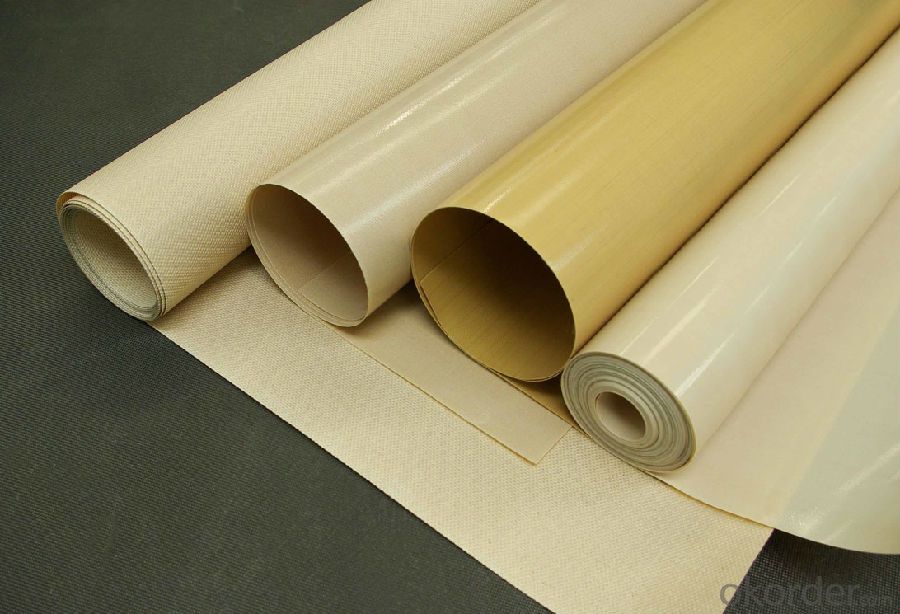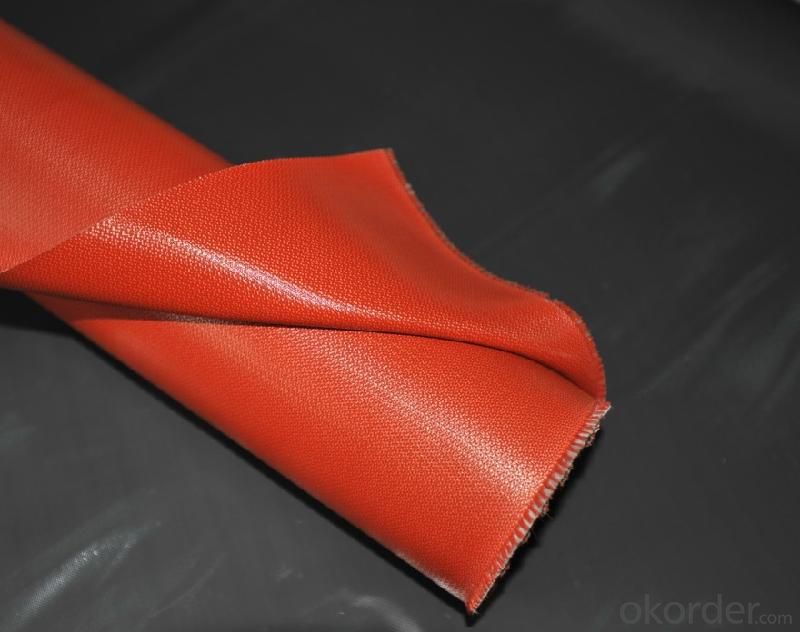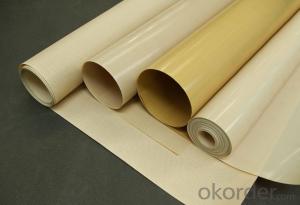Silicone Coated Fiberglass Fabric for Large Generating Corrosion Proofing Field
- Loading Port:
- Shanghai
- Payment Terms:
- TT OR LC
- Min Order Qty:
- 500 m²
- Supply Capability:
- 50000 m²/month
OKorder Service Pledge
OKorder Financial Service
You Might Also Like
Silicone Coated Fiberglass Fabric for Large Generating Corrosion Proofing Field
Fiberglass Fabric Description
Silicone coated fiberglass fabric is a fiberglass cloth, which possesses the properties of temperature resistance, anti-corrosion, high strength and is coated with organic silicone rubber.
Fiberglass Fabric Specification
Thickness:0.2mm-5mm
Width:100cm-150cm
Color;grey/red/silver/black
Weight(coating):130gsm-2800gsm
Model No | FSD2030 | FSD2030 | FSD2050 | FSD2100 | |
High temperature resistant(°C) | ≤280 | ≤280 | ≤280 | ≤280 | |
Low temperature resistant(°C) | ≥-40 | ≥-40 | ≥-40 | ≥-40 | |
Tensile intensity (N/50mm) | Warp | ≥1750 | ≥1750 | ≥2500 | ≥3500 |
Weft | ≥1280 | ≥1280 | ≥2100 | ≥3000 | |
Inflating burst intensity(Mpa) | ≥2.0 | ≥2.0 | ≥2.2 | ≥2.6 | |
Peeling intensity(N/m) | ≥450 | ≥450 | ≥520 | ≥600 | |
Insulation (kv/mm) | 16 | 16 | 18 | 18 | |
Weight (g/m*m) | 550-650 | 550-650 | 750-800 | 1500-1800 | |
Width(mm) | 1000±20 | 1000±20 | 1000±20 | 1000±20 | |
Thickness(mm) | 0.3-0.4 | 0.3-0.4 | 0.05-0.55 | 1.0-1.1 | |
color | Silver-gray, gray, red | lucency | Silver-gray, gray, red | Black, gray, red | |
Fiberglass Fabric Features:
1, Good performance on resisting high temperature and low temperature, -40°C-280°C;
2, High strength;
3, Ozone, oxide, light and weather aging resistance;
4, High insulation: dielectric constant:3-3.2, breakdown voltage: 20-50KV/MM;
5, Chemical corrosion resistant, oil-proofing, waterproofing (washable)
Fiberglass Fabric Application:
It has been widely used in construction, electric insulation,
chemical industry, pipeline ductile conjunction, large generating
Corrosion proofing field, machinery, metallurgy, sealing and so on.
Product Show


FAQ
1.What are the characteristics of fiberglass fabric?
a)Outstanding temperature resistance(from -70°C to +260°C)
b)Excellent chemical resistance
c)Superior non-stick surface, easy to clean
d)High dielectric strength
e)Dimensional stability
f)Resistance to UV, IR and HF
g)Non-toxic
2.How many methods to weave the fabric?
Four methods to weave the fabric:
a).Plain weave: it can be used in electricity insulation materials and reinforced materials in industry, because of inseparable structure, plain and clear lines.
b).Twill weave: compared with plain weave, it is of high density, high intensity, with a soft and loose structural weave. It can be used in ordinary reinforced materials, filter materials, and painting cloth.
c) Satin weave: compared with plain weave and twill weave, it is of high density,high intensity, with a soft and loose structural weave with a good texture. It is applicable for use as a higher reinforced material in machinery.
d).Gauze weave: said lattice twist weave. It can be used in spread model curtain,resin reinforced emery wheel gray cloth and lattice embed belt.
3.Can you offer us some samples?
We are willing to offer our customers best product&service,if it's necessary we can send
you sample for test;also we welcome all you customer have a trial order.
- Q:What are the different fiberglass fabric coatings for corrosion resistance?
- Corrosion resistance can be achieved through various types of fiberglass fabric coatings. The most commonly utilized coatings encompass: 1. Silicone: Silicone coatings are highly effective against corrosion and elevated temperatures, making them ideal for harsh environments characterized by chemical exposure and extreme temperatures. 2. Polyurethane: Boasting superior chemical resistance, polyurethane coatings are suitable for applications where exposure to corrosive substances is frequent. They also exhibit notable abrasion resistance and can withstand harsh weather conditions. 3. Epoxy: Epoxy coatings are renowned for their exceptional adhesion and chemical resistance, making them prevalent in marine and offshore industries where exposure to saltwater and other corrosive elements is prevalent. 4. Vinyl ester: Highly resistant to chemicals, acids, and alkalis, vinyl ester coatings find common usage in industries requiring superior corrosion resistance, such as the chemical processing industry. 5. Polyester: Polyester coatings offer commendable resistance against corrosion and UV radiation. They are commonly found in outdoor applications where sunlight and weather conditions can cause degradation. Each fiberglass fabric coating possesses distinct properties and advantages, necessitating careful consideration of specific requirements before selecting the appropriate coating. Factors like corrosive substances present, temperature conditions, and desired lifespan of the coating should be thoroughly assessed to ensure optimal corrosion resistance.
- Q:How is fiberglass fabric cleaned and maintained?
- Fiberglass fabric can be cleaned and maintained by following a few simple steps. Firstly, it is important to remove any loose debris or dirt from the fabric using a soft brush or vacuum cleaner. Next, prepare a mixture of mild detergent and warm water and gently scrub the fabric using a soft cloth or sponge. Rinse thoroughly with clean water and allow it to air dry. It is essential to avoid using harsh chemicals, abrasive cleaners, or brushes that can damage the fabric. Regular maintenance includes keeping the fabric free from excessive dirt or grime and promptly treating any stains or spills. Additionally, it is advisable to store fiberglass fabric in a clean and dry area to prevent any potential damage.
- Q:Two, fat and PVC paste resin paste into the sizing, coated on glass fiber cloth, so that after baking, how do not shrink?
- Do not grind finer, the particles are too small at room temperature, often because of excessive solvent and paste viscosity high.
- Q:What type of needle is used for sewing fiberglass fabric?
- A heavy-duty needle is the common type used for sewing fiberglass fabric. Its design is specifically made to endure the abrasive nature of fiberglass, featuring a sharp point and a thick shaft to penetrate the dense fibers of the fabric. Manufacturers typically construct it using robust materials such as stainless steel or titanium, guaranteeing its resistance to breakage or bending during the sewing process. Moreover, some sewers may opt for a needle coated with Teflon to minimize friction and prevent the fiberglass fabric from adhering to the needle. In summary, the use of a heavy-duty needle is vital when sewing fiberglass fabric to ensure successful stitching through the resilient fibers without causing any harm or breakage.
- Q:Is fiberglass fabric resistant to UV degradation in outdoor applications?
- Yes, fiberglass fabric is highly resistant to UV degradation in outdoor applications. Fiberglass fabric is made from fibers that are manufactured to withstand prolonged exposure to sunlight and other environmental factors. The fabric is treated with special coatings or finishes that provide additional protection against UV radiation. This UV resistance makes fiberglass fabric an ideal choice for outdoor applications where exposure to sunlight is a concern, such as in awnings, canopies, and outdoor furniture. Additionally, fiberglass fabric maintains its strength and integrity even after years of exposure to UV rays, ensuring its long-lasting performance in outdoor settings.
- Q:What is the tensile strength of fiberglass fabric?
- The tensile strength of fiberglass fabric can vary depending on the specific type of fabric and its manufacturing process. However, on average, fiberglass fabric typically has a tensile strength ranging from 100,000 to 500,000 pounds per square inch (psi).
- Q:How does fiberglass fabric handle moisture absorption?
- Fiberglass fabric possesses excellent resistance to moisture absorption, thanks to its hydrophobic nature. It does not readily absorb water or moisture due to the composition of fiberglass, which consists of thin strands of glass fibers woven together. These glass fibers are coated with a protective layer or resin, further enhancing the fabric's resistance to water penetration. The hydrophobic nature of fiberglass fabric makes it highly suitable for applications expecting exposure to moisture, such as outdoor or marine environments. Unlike materials like cotton or natural fibers, fiberglass fabric does not become waterlogged or lose its structural integrity when exposed to water. It remains unaffected by swelling, stretching, or deterioration, thereby maintaining its strength and durability over time. Additionally, the low moisture absorption of fiberglass fabric contributes to its resistance against mold, mildew, and rot. Unlike organic materials that provide a favorable environment for the growth of these organisms, fiberglass fabric does not offer a suitable food source or moisture content for their development. This makes it highly suitable for applications where moisture control and prevention of microbial growth are crucial, such as in insulation, construction, or automotive industries. In conclusion, the moisture resistance properties of fiberglass fabric make it an excellent choice for applications expecting exposure to water or moisture. Its ability to repel water and maintain its structural integrity when wet ensures its reliability and durability in various industries.
- Q:Are fiberglass fabrics suitable for use in the renewable energy sector?
- Fiberglass fabrics have proven to be well-suited for utilization in the renewable energy field. Known for their exceptional strength and durability, fiberglass fabrics are highly suitable for a wide range of applications within the realm of renewable energy. One notable application of fiberglass fabrics in the renewable energy sector is their use in the production of wind turbine blades. These fabrics are utilized to reinforce the blades, granting them the necessary strength to withstand strong winds and turbulent conditions. Additionally, the lightweight nature of fiberglass permits the creation of lengthier blades, ultimately leading to an amplified energy output. Moreover, fiberglass fabrics also find use in the manufacturing of solar panels. They frequently serve as a protective layer, encapsulating the photovoltaic cells and providing insulation. With admirable electrical insulation properties, fiberglass fabrics guarantee the durability and effectiveness of solar panels. Furthermore, fiberglass fabrics contribute to the construction of thermal insulation materials for solar water heaters and geothermal systems. By aiding in heat retention, these fabrics enhance the efficiency of these renewable energy systems. Additionally, fiberglass fabrics possess resistance to corrosion and exhibit an extensive lifespan, rendering them suitable for deployment in marine renewable energy projects such as wave energy converters and tidal turbines. These fabrics can withstand the harsh marine environment while simultaneously providing structural support to these devices. In conclusion, fiberglass fabrics boast numerous applications in the renewable energy sector. Their strength, durability, electrical insulation properties, and resistance to corrosion make them an exceptional choice for an array of renewable energy technologies, including wind turbines, solar panels, thermal insulation materials, and marine energy devices.
- Q:How long does fiberglass fabric typically last?
- Fiberglass fabric possesses a reputation for its durability and longevity, making it a favored choice across various applications. The duration of its lifespan is contingent upon several factors, including fabric quality, exposure to external elements, and maintenance measures. On average, fiberglass fabric can endure for anywhere between 10 to 30 years. However, by implementing appropriate care and maintenance, it is feasible for its longevity to surpass these estimations. Consistent cleaning, prevention of excessive exposure to harsh chemicals or extreme temperatures, and avoidance of physical harm are all instrumental in significantly extending the lifespan of fiberglass fabric. It is crucial to acknowledge that fiberglass fabric can become brittle and compromise its structural integrity over time, particularly when subjected to continuous high temperatures or harsh environmental conditions. Moreover, natural wear and tear can contribute to its eventual deterioration. To guarantee the utmost longevity for fiberglass fabric, it is advisable to adhere to the manufacturer's maintenance and care guidelines. Regular inspections to identify signs of damage or wear, along with immediate repairs or replacements when necessary, can greatly contribute to prolonging the fabric's lifespan.
- Q:Can fiberglass fabric be used for reinforcement in agricultural tanks?
- Yes, fiberglass fabric can be used for reinforcement in agricultural tanks. Fiberglass fabric is known for its high strength and durability, making it an ideal material for reinforcing various structures, including tanks. It is resistant to corrosion, chemicals, and weathering, which are essential properties for agricultural tanks that may be exposed to harsh conditions. Additionally, fiberglass fabric is lightweight, which makes it easier to handle and install in tanks. Overall, using fiberglass fabric for reinforcement in agricultural tanks can enhance their structural integrity and longevity.
1. Manufacturer Overview |
|
|---|---|
| Location | |
| Year Established | |
| Annual Output Value | |
| Main Markets | |
| Company Certifications | |
2. Manufacturer Certificates |
|
|---|---|
| a) Certification Name | |
| Range | |
| Reference | |
| Validity Period | |
3. Manufacturer Capability |
|
|---|---|
| a)Trade Capacity | |
| Nearest Port | |
| Export Percentage | |
| No.of Employees in Trade Department | |
| Language Spoken: | |
| b)Factory Information | |
| Factory Size: | |
| No. of Production Lines | |
| Contract Manufacturing | |
| Product Price Range | |
Send your message to us
Silicone Coated Fiberglass Fabric for Large Generating Corrosion Proofing Field
- Loading Port:
- Shanghai
- Payment Terms:
- TT OR LC
- Min Order Qty:
- 500 m²
- Supply Capability:
- 50000 m²/month
OKorder Service Pledge
OKorder Financial Service
Similar products
New products
Hot products
Related keywords




























